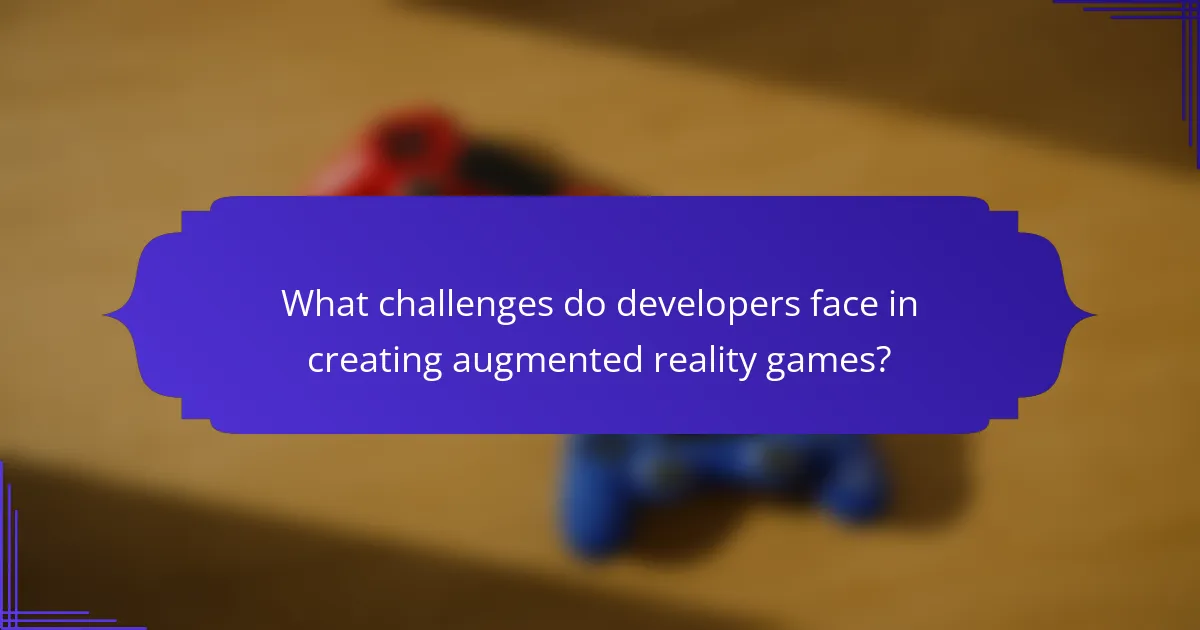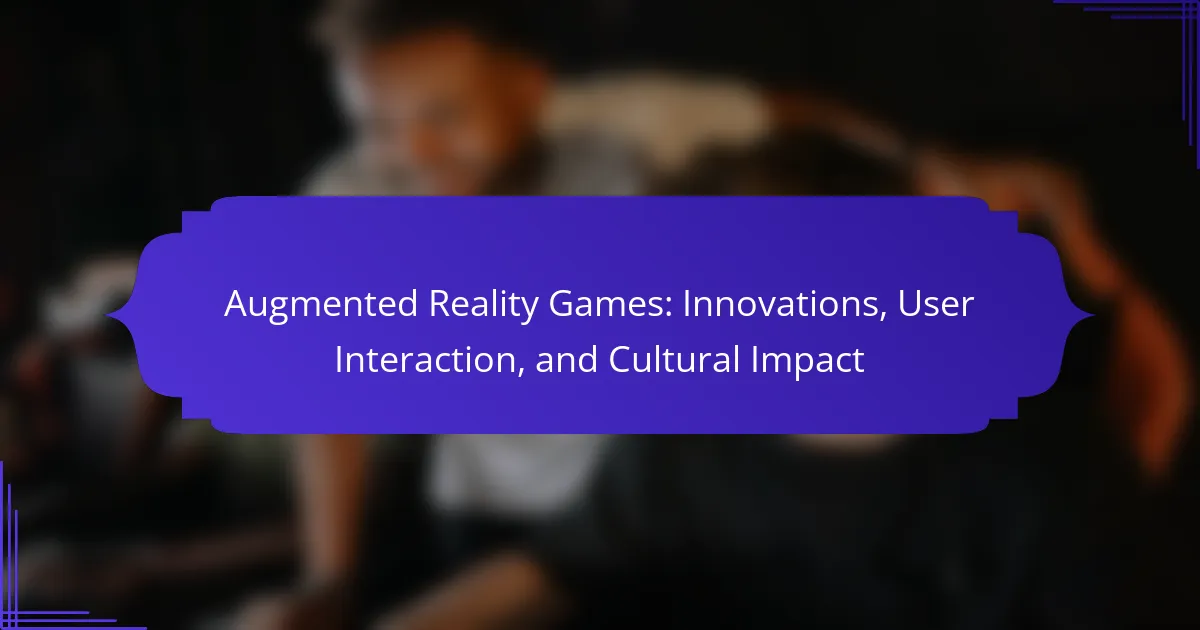Augmented reality games are reshaping user interaction and cultural engagement in gaming. Key innovations enhance immersive experiences through advanced computer vision, location-based technology, and social features. Players engage with real-world environments, fostering community connections and educational opportunities. The evolving landscape also presents challenges for developers in creating intuitive and compatible gaming experiences.

What are the key innovations driving augmented reality games?
Key innovations driving augmented reality games include advanced computer vision, location-based technology, and social interaction features. These innovations enhance user experiences by creating immersive environments and facilitating real-time interactions. For example, computer vision enables accurate object recognition, while location-based technology allows games to integrate with the real world. Social interaction features encourage collaboration and competition among players, significantly impacting cultural engagement and community building in gaming.
How do technological advancements enhance user experiences?
Technological advancements enhance user experiences in augmented reality games by providing immersive interactions and cultural engagement. Innovations like real-time environmental mapping and social connectivity allow players to interact seamlessly with virtual elements. These advancements create unique gaming experiences, fostering community and cultural storytelling. Enhanced graphics and haptic feedback further deepen immersion, making gameplay more engaging. As a result, users enjoy a richer, more interactive experience that transcends traditional gaming boundaries.
Which platforms are leading the augmented reality gaming market?
Leading platforms in the augmented reality gaming market include Niantic, Snap Inc., and Microsoft. Niantic’s Pokémon GO revolutionized mobile AR gaming, generating substantial user engagement. Snap Inc. enhances user interaction through AR filters and lenses, integrating social media with gaming. Microsoft’s HoloLens offers immersive experiences, targeting enterprise applications and educational use. Each platform showcases unique attributes, driving innovations and cultural impacts in augmented reality gaming.
What role do mobile devices play in the accessibility of augmented reality games?
Mobile devices significantly enhance the accessibility of augmented reality games by providing necessary hardware and software. They enable users to interact with digital content seamlessly in real-world environments. The portability of smartphones and tablets allows players to engage with augmented reality experiences anywhere, increasing user engagement and participation. Furthermore, the widespread adoption of mobile devices ensures a larger audience for these games, fostering innovation and cultural integration. The integration of advanced sensors and cameras in mobile devices enhances the immersive experience, making augmented reality games more interactive and enjoyable.

How do players interact with augmented reality games?
Players interact with augmented reality games through immersive experiences that blend digital content with the physical world. These games utilize devices like smartphones and AR glasses to enhance gameplay. Players engage by exploring real environments, completing tasks, and interacting with virtual objects.
Key interaction methods include location-based challenges, social collaboration, and real-time feedback, which enhance user engagement. For instance, games like Pokémon GO encourage players to explore neighborhoods, fostering community interaction. This unique blend of physical and digital realms creates a cultural impact, influencing social behaviors and gaming trends.
What are the most common user engagement strategies in AR games?
Augmented reality games commonly engage users through interactive storytelling, social features, location-based challenges, and gamification elements. These strategies enhance user experience and promote sustained interaction.
Interactive storytelling immerses players in narratives that evolve based on their choices. Social features enable collaboration and competition among players, fostering community engagement. Location-based challenges leverage real-world environments, encouraging exploration. Gamification elements, such as rewards and achievements, motivate users to participate consistently.
How does social interaction influence gameplay in augmented reality environments?
Social interaction significantly enhances gameplay in augmented reality environments by fostering collaboration and competition among players. This interaction leads to increased engagement and immersion, as players share experiences and strategies in real-time.
Augmented reality games often incorporate social features, such as team challenges and leaderboards, which encourage players to connect. These features create a unique attribute of community-driven gameplay, where social dynamics influence individual performance and enjoyment.
As a result, players experience a richer, more dynamic gaming environment that reflects real-world social interactions. This cultural impact is evident in the way players form communities, share content, and influence game design through collective feedback.
Which design elements enhance user immersion in AR games?
Interactive design elements, realistic graphics, and adaptive audio enhance user immersion in AR games. These features create a seamless blend of the virtual and real worlds, fostering deeper engagement.
1. Interactive design elements: Allow players to manipulate their environment, increasing involvement.
2. Realistic graphics: Provide lifelike visuals that enhance the sense of presence.
3. Adaptive audio: Creates an immersive soundscape that responds to players’ actions and surroundings.
4. Spatial awareness: Utilizes the player’s physical space to enhance gameplay experiences.
5. Haptic feedback: Offers tactile sensations that reinforce interactions and actions within the game.

What cultural impacts do augmented reality games have on society?
Augmented reality games significantly influence society by enhancing social interactions and cultural experiences. They foster community engagement through shared experiences and collaborative gameplay. These games often blend digital content with real-world settings, reshaping how players perceive their environment. For example, Pokémon GO encouraged outdoor exploration and socialization among players. Additionally, augmented reality games promote cultural awareness by integrating local history and landmarks into gameplay, creating educational opportunities. As a result, they contribute to a more interconnected and culturally enriched society.
How do AR games influence social behavior and community building?
Augmented reality games enhance social behavior and foster community building through immersive experiences. These games encourage collaboration and interaction among players, leading to the formation of social bonds.
Players often engage in cooperative tasks, which require communication and teamwork. This interaction can strengthen existing friendships and help forge new connections. For instance, community events in AR games promote local gatherings, enhancing social cohesion.
Moreover, AR games can stimulate community engagement by encouraging players to explore their surroundings. This exploration fosters a sense of belonging and encourages players to participate in local activities. As a result, the impact of AR games extends beyond the digital realm, influencing real-world social dynamics.
In what ways do augmented reality games reflect regional cultural themes?
Augmented reality games reflect regional cultural themes through immersive storytelling, local landmarks, and community engagement. These games often incorporate folklore and traditions, enhancing players’ connection to their heritage. For instance, a game set in Japan may feature Shinto shrines and local myths, while one in Mexico might highlight Day of the Dead celebrations. This integration fosters cultural pride and educates players about their surroundings. Additionally, user-generated content allows communities to contribute their narratives, further enriching the cultural experience.
What are the educational benefits of augmented reality games in various cultures?
Augmented reality games enhance education across cultures by promoting interactive learning, engagement, and cultural awareness. These games provide immersive experiences that facilitate understanding of diverse subjects, including history and science.
For example, AR games can simulate historical events, allowing players to experience different cultures firsthand. This interactive format fosters empathy and appreciation for cultural diversity. Additionally, AR games can adapt to various educational systems, making them versatile tools for global learning environments.
Research indicates that students using AR games show improved retention rates and motivation. The blend of technology and education in these games supports collaborative learning, making education more accessible and enjoyable.

What challenges do developers face in creating augmented reality games?
Developers face numerous challenges in creating augmented reality games, including technical limitations, user interface design, and hardware compatibility. Technical limitations often stem from the need for high-performance graphics and real-time processing, which can strain devices. User interface design poses a unique challenge, as developers must create intuitive interactions that feel natural in a mixed-reality environment. Hardware compatibility is critical, as not all devices support the same AR functionalities, leading to inconsistent user experiences. Additionally, developers must navigate the complexities of user engagement and retention in an evolving market.
How do technical limitations affect game design and user experience?
Technical limitations significantly hinder game design and user experience in augmented reality games. These constraints affect graphics quality, interaction fluidity, and overall immersion. For instance, limited processing power can reduce the complexity of virtual objects, impacting realism. Additionally, hardware restrictions can constrain user interaction, making it less intuitive. As a result, developers must balance creative ambitions with technological capabilities to enhance player engagement while ensuring smooth performance.
What ethical considerations arise from augmented reality gaming?
Ethical considerations in augmented reality gaming include privacy concerns, data security, and the potential for addiction. These games often require access to personal data, raising issues about user consent and data misuse. Additionally, the immersive nature can blur the lines between virtual and real-world interactions, impacting social behavior. As a result, developers must prioritize ethical standards to ensure user safety and responsible gameplay.

Which unique features differentiate popular augmented reality games?
Popular augmented reality games are distinguished by unique features such as immersive gameplay, social interaction, and location-based experiences. These attributes enhance user engagement and foster community building. For instance, games like Pokémon GO utilize real-world locations to create a sense of adventure. Additionally, interactive elements like augmented visuals and sound effects contribute to a more enriched gaming experience. The integration of user-generated content further differentiates these games, allowing players to influence the game environment.
How do narrative elements enhance player engagement in AR games?
Narrative elements significantly enhance player engagement in augmented reality games by creating immersive experiences. These elements provide context and emotional depth, fostering a connection between players and the game world.
Storylines encourage exploration and interaction, motivating players to uncover narratives embedded in their surroundings. Additionally, characters with relatable traits enhance empathy, making players more invested in outcomes.
Moreover, dynamic storytelling adapts to player choices, ensuring unique experiences that increase replayability. This interactivity keeps players returning, enhancing the game’s cultural impact as they share personal stories and experiences.
Incorporating narrative elements transforms gameplay from mere mechanics into rich, engaging experiences, ultimately elevating player satisfaction and retention.
What innovative monetization strategies are used in augmented reality gaming?
Augmented reality games utilize innovative monetization strategies such as in-game purchases, subscription models, and advertising partnerships. These methods enhance user engagement while generating revenue. For instance, in-game purchases allow players to buy virtual goods, while subscription models offer exclusive content or features. Advertising partnerships can integrate brand promotions seamlessly into gameplay, providing additional income. These strategies leverage the immersive nature of augmented reality, creating unique user experiences that drive financial success.

How is augmented reality gaming evolving in 2025?
Augmented reality gaming is evolving rapidly in 2025 through enhanced user interaction, innovative technologies, and significant cultural impacts. Innovations include improved hardware, such as lightweight AR glasses, which provide immersive experiences. User interaction is becoming more intuitive with advancements in gesture recognition and voice commands. Cultural impacts are evident as AR games foster community engagement and social connections, influencing lifestyle and entertainment choices. Furthermore, the integration of AR in educational contexts enhances learning through interactive gameplay.
What emerging trends should players and developers watch for?
Augmented reality games are evolving rapidly, with trends focusing on immersive experiences, social interaction, and real-world integration. Developers should prioritize user-generated content, enhancing personalization and engagement. Additionally, advancements in AR technology, like improved tracking and graphics, will reshape gameplay. Cultural impact will grow as these games promote collaboration and community building.
How might augmented reality games shape future entertainment experiences?
Augmented reality games will significantly enhance future entertainment experiences through immersive interactions and personalized content. These games blend digital elements with the real world, creating unique user experiences. Innovations in AR technology, such as improved graphics and real-time data integration, will allow players to engage more deeply with narratives and environments. Cultural impacts include fostering social connections and community engagement, as players collaborate and compete in shared spaces. As AR gaming evolves, it will redefine how audiences experience storytelling and play, making entertainment more interactive and engaging.
What best practices can developers adopt to optimize user experience in AR gaming?
Developers can enhance user experience in AR gaming by focusing on intuitive controls, seamless integration of virtual elements, and optimizing performance. Prioritizing user feedback helps refine gameplay mechanics and interface design.
Implementing adaptive difficulty levels ensures engagement across various skill levels. Regular updates with new content maintain user interest and foster community interaction.
Incorporating social features, such as multiplayer options, enhances collaboration and competition, enriching the overall experience.
Lastly, ensuring compatibility across devices maximizes accessibility, allowing a broader audience to enjoy the game.
